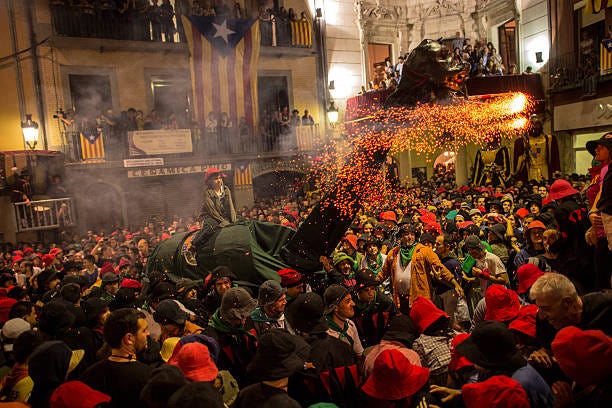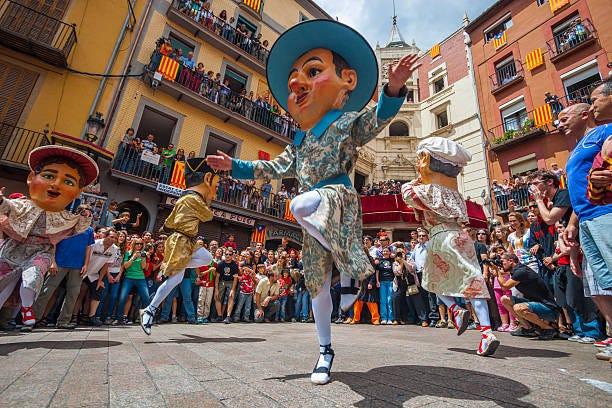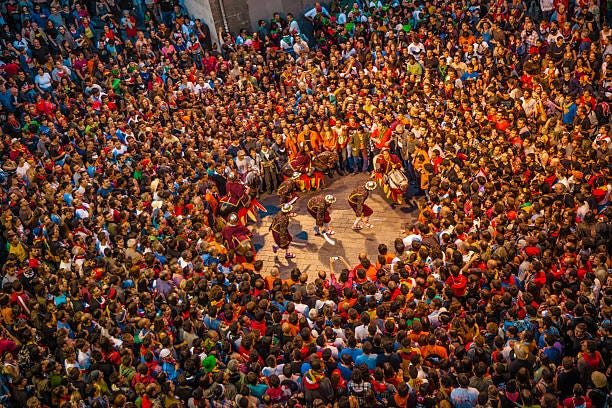👺🐲🦅The Patum of Berga! 🎇
Another bizarre Corpus Christi festival of pagan origins, with dancing devils, dwarves, fire-breathing dragons, Turks and knights, and of course, plenty of pyrotechnics!
I’m sure I’ve mentioned a few times before how Spain has its fair share of weird and wacky festivals. When you take its long history of pagan Celtiberian and Roman traditions and mix them with the later Catholic ones, you’re going to end up with something interesting, to say the least.
In the early Middle Ages, it was easier for the Church to convert the local pagans by assimilating their customs into the Christian stories, replacing pagan gods with saints, and important festive days that honoured the seasons with holy days. This blending of traditions is known as syncretism and is what makes Spanish fiestas such a unique mishmash of images, rituals, and symbolism.
A perfect example of this is during Corpus Christi which takes place nine weeks after Easter (itself a religious holiday with pagan origins). The Church has made sure there are plenty of Masses and other religious observances to follow during this holiday, but they haven’t managed to wipe out the more colourful and creative elements such as jumping over newborn babies, being wrapped in a thick layer of moss, transforming an entire town into a verdant green maze, observing dancing eggs in fountains, or designing enormous elaborate carpets of flowers, and so on.
The Patum festival that takes place in the Catalan town of Berga every Corpus Christi is another great example of this melding of pre-Christian and Catholic lore. What started as a way to explain the scriptures and morals to an illiterate public through short simple plays during the Middle Ages, took on a life of its own when blended with the more ancient symbols of effigies, masks, mythical creatures, and the transformative power of fire-breathing dragons.
Over time these plays became more dramatic than instructive and despite civil, religious, and royal powers prohibiting the festival in other towns and cities around Catalunya, Berga has remained the only town to preserve the tradition. And as with so many other festivals around Spain, its goal is not to attract tourism, but to celebrate the pride the locals have for their history and cultural identity. You often need to be a local to understand what’s going on in these more obscure festivals as they can seem incomprehensible to the outsider. Many festivals, including the Patum festival hold a children’s version, ensuring the next generations continue the tradition.

Patum kicks off on the eve of Corpus Christi Thursday with the Tabaler (Town Crier) heralding in the festival by beating his oversized drum (the Tabal) with a pa-tum, pa-tum – the sound which has given the festival its name. According to tradition, the Tabal holds the power of being able to ensure good weather by clearing the sky of clouds. Dancing processional giants representing Moors accompany the Tabaler through the streets, squeezing their way through the crowds.
Thousands of people pack into San Pere Square and the neighbouring narrow streets, so tightly sardined it makes you wonder if the discomfort of not being able to move for several hours is part of its charm. As the assortment of angels, devils, bigheads, dwarves, and dragons enter the square to dance, there are people responsible for holding the crowds back to give them space. Maybe the lack of a cordoned off area for the dancers means the squeeze is part of the show.
The elements that make up the Patum festival and the dances include:
The Turks and the Little Horses
This dance dates back to at least 1621 and involves the secular struggle between the Christians and the Moors with four knights on tiny papier mâché horses and four Turkish foot soldiers re-enacting a battle in which the Christians are always victorious.
The Maces
Maces are long handles topped with a round box in which a few stones are placed to create the distinctive rattle when shaken. Above the box are firecrackers and are carried around by the demons who “fight” the angels in the eternal dance between good and evil.

Mule Dragons
These are one of the oldest elements of the festival with their shape unchanged since the Middle Ages. The green puppet dragons with long necks are carried by participants who chase the crowds while firecrackers spark from the dragons’ jaws.
The Eagle
The eagle is one of the most recognisable and popular characters though its origin is unknown. It was incorporated into the Corpus Christi processions in 1756 and has the most choreographed dances of all the performances. It is also the most regal of all characters, a symbol of power, and it carries the shield of Berga.
Old Dwarves
These are four characters with large papier mâché heads, tricorn hats, and long wigs, and dance along to castanets.
New Dwarves
These were introduced in 1890 to replace the Old dwarves that were falling apart, though later restored. The New Dwarves represent two couples of different ages dancing.
Giants
Giants have long been an important part of Catalan festivals and often represent historic figures, such as kings or queens. Here they represent two couples of vanquished Moorish warlords that dance together.
Fire Demons
The climax of the festival that takes place on the Sunday after Corpus Christi, is the dance of the fire demons. About 100 demons dressed in fresh green grass to protect themselves from the sparks, carry explosive firecrackers and take to the darkened streets simulating an infernal hell pit.

In 2005, the Patum festival was declared an Intangible Cultural Heritage of Humanity recognising its unique features that date back to the 13th century. Its mix of medieval street theatre and emblematic representations makes its one of Spain’s most remarkable fiestas.






